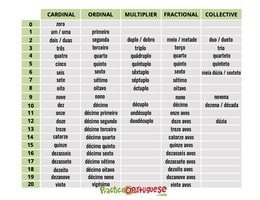In this unit, we’ll learn about Portuguese numbers, known as númerosnumbers or numeraisnumerals .
Números are just one type of quantificadoresquantifiers , but they are so important that we thought they deserved their own unit. We’ll explore some of the other quantifiers in the How Much? How Many? unit. But for now, let’s go over the números, which simply tell us the specific, numeric amount of a particular something.
The 5 Types of Numbers:
- cardinaiscardinal – Cardinal numbers: 1, 2, 3…
- ordinaisordinal – Ordinal numbers: First, second, third…
- multiplicativosmultiplier – Multiplier numbers: Double, triple, quadruple…
- fracionáriosfractional – Fractional numbers: Half (1/2), third (1/3), fourth (1/4)…
- coletivoscollective – Collective numbers: Duo, trio, dozen…
We’ll focus on the cardinal numbers up to 15 in this first unit (Numbers 1) and then in Numbers 2, we’ll practice forming higher numbers in the tens, as well as numbers in the hundreds and thousands. In Numbers 3, we’ll explore ordinal, multiplier, fractional, and collective numbers. Below you’ll find a handy reference chart with all 5 types of Portuguese numbers.
Portuguese Numbers Reference Chart:

Download the Featured PDF for free below
 We hate spam and guarantee you 100% privacy. You can unsubscribe at any time.
We hate spam and guarantee you 100% privacy. You can unsubscribe at any time.Portuguese Numbers Notation
In some English-speaking countries, such as the US and UK, numbers are typically written as such: 12,345.67. In Portugal, however, it would be 12.345,67 with the comma and decimal point reversed. Alternatively, you may just see a space instead of a comma or decimal point for large whole numbers, as in 20 000 (instead of 20,000 or 20.000). Note: In our exercises, we typically avoid any spacing or punctuation, just to keep things simple when entering your response.






 Download PDF
Download PDF
Muito útil agora com clipes de áudio.
It is interesting that in the audio clips of numbers ending in “e” such as “sete”, “nove”, “catorze”, etc. the normal speed voice does not pronounce the final “e”, however in the slow clips (turtles) there the final “e” is sounded. As I remember these final “e”s were pronounced in Brazil, and it is hard for me to get out of that habit. Does this vary between different speakers or regional accents in Portugal? Would all European Portuguese speakers pronounce these final “e”s if speaking slowly, but drop them in normal speech? Probably this is not an important point, but I am curious. Muito obrigado
Yes, those final Es are often dropped in European Portuguese in normal speech and may also be dropped when speaking slowly. I don’t think there’s any regional variation, but I couldn’t confirm this. One variation you might notice between different speakers is when those words are followed by another word that starts with a vowel, e.g. “sete anos”. Many people will drop the E as usual and say “setanos“, while others will turn the E into an I (“ee” sound, in English) with which they link the two words: “setianos“. I also can’t say that there’s any regional pattern for that, just something I notice in different people 🙂
Obrigado. It is interesting but sometimes confusing to hear some of these variations. However, we have the same sort of thing in English as well. I appreciate your detailed answer.
The chart is really helpful. As a beginner, I need a bit of clarification. For 1 and 2, are those masculine and feminine and are they the only two numbers that have M/F versions? How do I know which one to use? Also, can you add zero to the chart? Many phone numbers, NIFs, addresses have zeros and I want to make sure I am saying and hearing it right. Thanks!
Yes those are the only numbers that have M/F versions. This includes any numbers that end in 1 or 2 also. For example: vinte e duas pessoas (fem.) vs. vinte e dois carros (masc.).
Just added zero! Thanks for pointing that out. 🙂
Thanks for the speedy response! Of course I found the answers right after I pressed send. And thanks for adding zero!
Why is Tuesday terça-feira instead of terceira-feira?
Terça and terceira are synonyms, both derived from the Latin word tertia. I don’t have a solid answer for why the day of the week became Terça, but it could’ve been to avoid the jarring rhyme in terceira-feira.
Olã,
I love your brilliant way of teaching portuguese!
When I read the list above I saw that you wrote “séptublo” but the other 7´s lost this p. The same with “septuagésimo” and “septingentésimo”. I know that in the past, bevore the reform the p was used more often. Is there a rule for this?
Muito obrigada!
Thank you, Andrea!
Sete and sétimo already had this spelling under the previous norm, so nothing changed for them. Séptuplo has a double spelling, with or without the first P, probably because the pronunciation varies across regions, so they made room for both variations. The P in septuagésimo and septingentésimo has always been pronounced, so these words also retained their previous spelling. Basically, the spelling reform only cut off muted consonants (apart from H in Portugal). If they are pronounced, they stay 🙂
Thank you so much, Joseph!
Good technique to learn language
Like others have mentioned, some of the words seemed to drop the last syllable/sound of o and others did not. Also, I caught a difference in the word nove. In one case, it was NAWV for 9 but later, for 90, it was NOOVenta. Help me know the difference? Thank you!
Olá! The word ‘nove’ (9) per se is stressed on the first syllable, which makes the respective vowel sound more open. But in ‘noventa’ (90), the word is merged with the suffix ‘-enta’ and the stress changes to the middle syllable, so the preceding O vowel (now unstressed) becomes more closed. Compare this also with ‘novecentos’ (900), where instead of suffixation, two actual nouns are stuck together, but remain intact otherwise (nove + centos). In this case, they retain their original pronunciations, which means that the ‘O’ in ‘nove’ stays open.
I also had all of these questions. Thank you for answering.
Nov is still difficult:
Nove
Noventa, etc
Thanks for the PDF chart, I have downloaded and printed it out, really useful learning tool
Thanks for the PDF. I wonder if you could do the same for a selection of verbs and tenses so we can print them out? Great app btw. Thank you
There’s a PDF about regular verb conjugations on this page that you may find useful: Most Common Portuguese Verbs 🙂
Hello, I just want to ask if the pronunciations are Brazillian or Portuguese. Also the whole platform is great but has different stuff sometimes from what I see on google translate. Are you teaching Portugal Portuguese or Brazillian Portuguese?Thanks
Olá! Our platform focuses only on European Portuguese, as spoken in Portugal. The pronunciations you hear in our lessons and materials are all in European Portuguese, with few & clearly marked exceptions in some podcasts. It’s only natural that Google Translate sometimes shows different things, whether because it often defaults to Brazilian Portuguese or because some words/phrases have multiple translation possibilities (and in each case, we have to use our judgment and consider which option best highlights what we want to teach/focus on at any given point). Feel free to reach out us via our support channel whenever you need further clarification 🙂